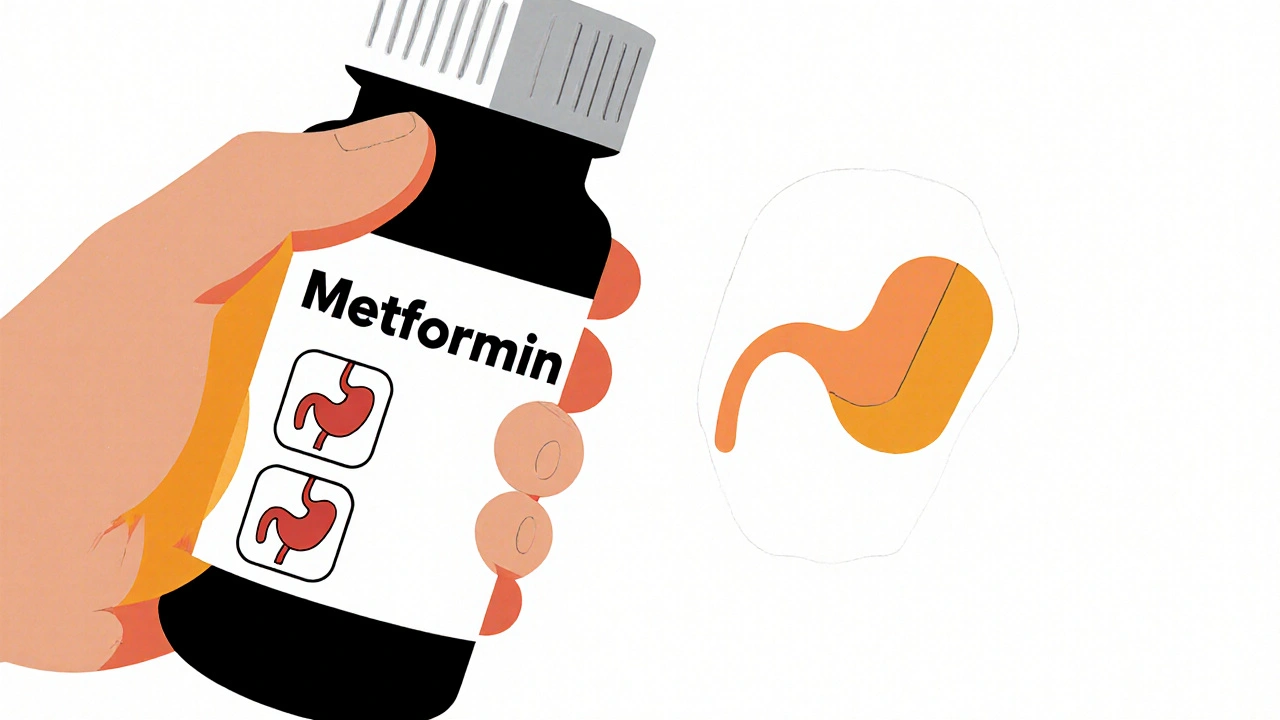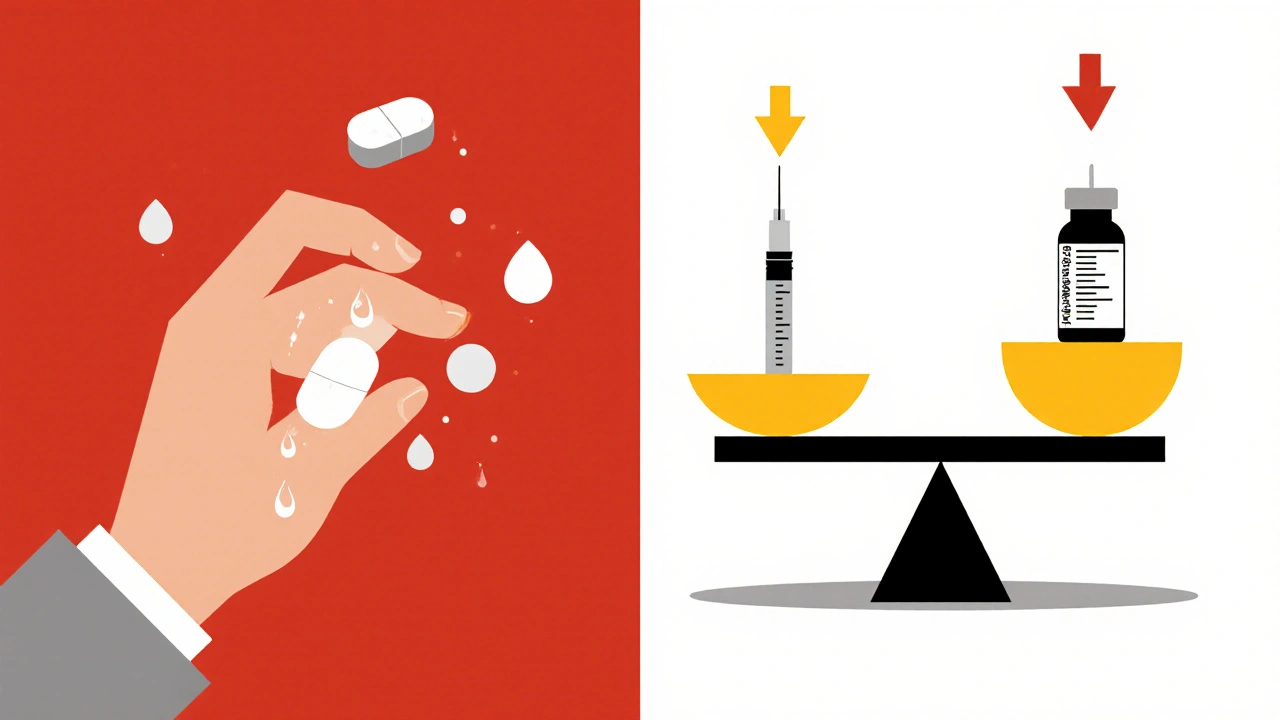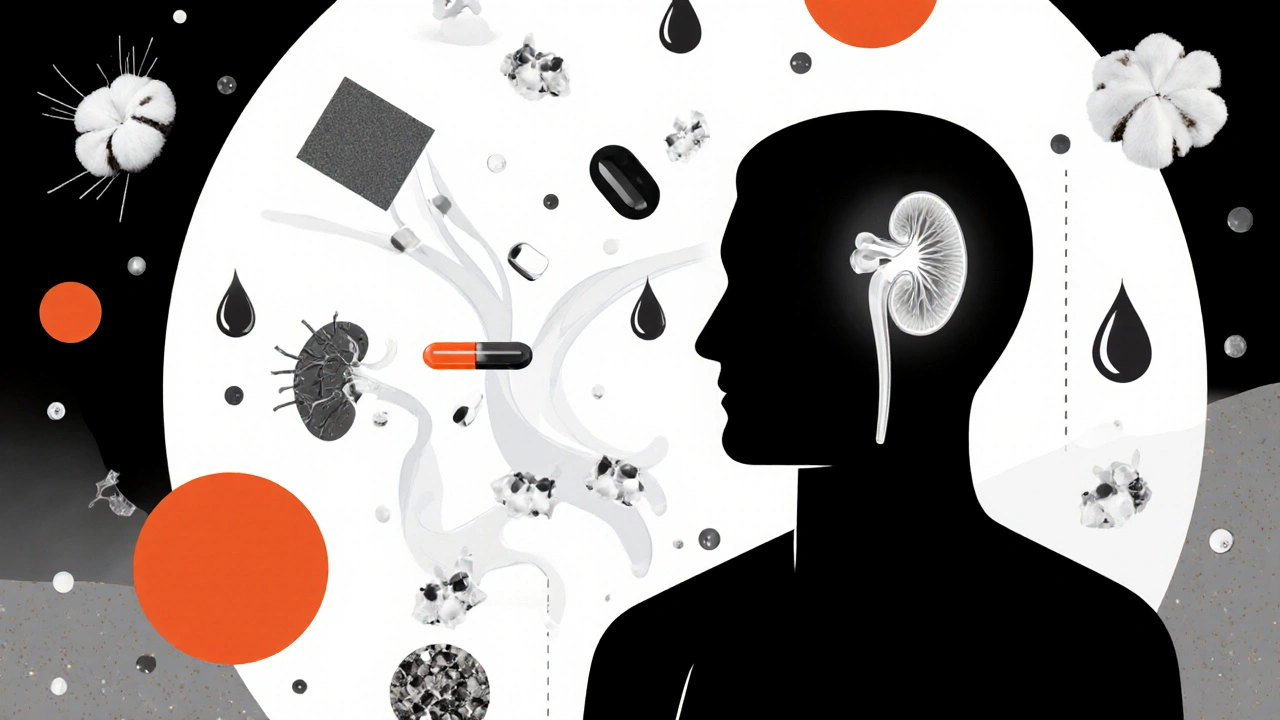Choosing Diabetes Medications Based on Side Effect Profiles: A Practical Guide for Type 2 Diabetes
 Nov, 26 2025
Nov, 26 2025
Diabetes Medication Side Effect Comparison Tool
Your Health Priorities
Select the side effects that concern you most. The tool will recommend medications that best match your priorities.
Medication Comparison
Based on your selections, here's how different medications compare:
| Medication Class | Low Blood Sugar Risk | Weight Impact | Heart Benefits | Kidney Benefits | Common Side Effects | Best For |
|---|---|---|---|---|---|---|
| Metformin (Extended-Release) | Low risk | No weight gain | No direct benefit | No direct benefit | GI issues (can be reduced with slow start) | First-line option for most patients |
| SGLT-2 Inhibitors | Low risk | Weight loss | 30% heart failure reduction | Slows kidney disease progression | Yeast infections (1-11%) | Heart or kidney disease patients |
| GLP-1 Agonists | Low risk | Significant weight loss | 26% heart attack/stroke reduction | No direct benefit | Nausea (initially) | Obesity and heart disease patients |
| DPP-4 Inhibitors | Very low risk | No weight gain | No direct benefit | No direct benefit | Mild cold-like symptoms | Older patients and those with kidney issues |
| Sulfonylureas | High risk | Weight gain | No direct benefit | No direct benefit | Hypoglycemia (up to 77%) | Avoid unless no other options |
Your Recommendations
Select your priorities above to see personalized recommendations.
When you're managing type 2 diabetes, the goal isn't just to lower your blood sugar-it's to do it in a way that fits your life. Some medications make you feel sick, others cause weight gain or low blood sugar episodes that leave you shaky and scared. The truth is, not all diabetes drugs are created equal when it comes to side effects. Choosing the right one isn’t about what works best on paper-it’s about what you can actually live with.
Metformin: The Starting Point, But Not for Everyone
Most doctors still start with metformin. It’s cheap, effective, and doesn’t cause weight gain or low blood sugar. But here’s the catch: about 30% of people get stomach problems-diarrhea, nausea, bloating-when they first start it. That’s not just annoying; it’s why nearly 1 in 5 people quit taking it within the first few months.
The fix? Start low. Take 500 mg once a day with your evening meal. Wait a week, then bump it up to 500 mg twice a day. Most people tolerate this slow start and reach the full 2,000 mg dose within a month. Switching to the extended-release version cuts GI side effects by more than half. One study showed 82% of users preferred the extended-release form because they could actually keep it down.
Metformin is safe for most people, but if your kidney function drops below an eGFR of 30, it’s no longer an option. That’s not rare-about 1 in 4 adults over 65 have some level of kidney decline. Your doctor should check this every year.
Sulfonylureas: The Hypoglycemia Trap
Drugs like glimepiride and glibenclamide have been around for decades. They work by forcing your pancreas to pump out more insulin. Simple. But that simplicity comes with a dangerous trade-off: low blood sugar.
Here’s the numbers: glibenclamide causes hypoglycemia in 77% of users. Glimepiride? Still high at 44%. That’s more than 1 in 2 people having scary episodes-sweating, shaking, confusion, even passing out. Older adults, people with irregular meals, or those who drive for a living are at highest risk. A 2023 study showed that switching from glibenclamide to glimepiride cut emergency room visits by 22%.
And it’s not just low blood sugar. These drugs make you gain weight-up to 26% of patients gain noticeable pounds. That’s the opposite of what most people with type 2 diabetes need. Surveys show 44% of people quit sulfonylureas within a year, mostly because of hypoglycemia and weight gain. If you’re older or active, avoid these unless there’s no other option.
SGLT-2 Inhibitors: Weight Loss and Infections
Drugs like empagliflozin and dapagliflozin work by making your kidneys flush out sugar through urine. That’s why they help with weight loss and heart health. But that same mechanism causes a common side effect: genital yeast infections.
Women see this more often-about 8-11% get infections. Men get them too, at 1-4%. It’s not dangerous, but it’s embarrassing and uncomfortable. The good news? Most are easy to treat with over-the-counter antifungal creams. A Michigan Health protocol that taught patients better hygiene reduced discontinuation due to infections by 35%.
There’s also a small risk of urinary tract infections and, very rarely, a serious condition called Fournier’s gangrene (about 2 in 100,000 people). The FDA added a warning for this in 2022, but prescriptions haven’t dropped. Why? Because these drugs also lower heart failure risk by up to 30% and slow kidney disease progression. For someone with heart or kidney problems, the benefits far outweigh the risks.
One more thing: these drugs can cause dehydration. If you’re sick, sweating a lot, or skipping meals, you might feel dizzy. Drink water. Don’t push through.

GLP-1 Receptor Agonists: Nausea, But Worth It
Liraglutide, semaglutide, tirzepatide-these injectables are changing the game. They slow digestion, reduce appetite, and lower blood sugar. The side effect? Nausea. Up to 45% of people feel sick when they start. Some vomit. Others get diarrhea.
But here’s the twist: most of that fades after 4-8 weeks. The LEAD-6 trial showed that using a "start low, go slow" method cuts nausea from 45% to just 18%. Start with the lowest dose. Wait 4 weeks before increasing. Most people adapt.
And what do they get in return? Weight loss. On average, people lose 7-8 kg in 6 months. For someone with obesity, that’s life-changing. Tirzepatide, the newest dual-action drug, leads to nearly 16% weight loss at the highest dose. That’s more than most bariatric surgeries.
These drugs also cut heart attacks and strokes by up to 26% in high-risk patients. That’s why the ADA now recommends them as first-line for people with heart disease or a BMI over 30. They’re expensive, yes-but the long-term savings on hospital visits and complications can be huge.
DPP-4 Inhibitors: The Middle Ground
Drugs like sitagliptin and linagliptin are often called "gentle". They don’t cause weight gain. They rarely cause low blood sugar-unless you’re taking them with a sulfonylurea. Then the risk jumps to 15-20%.
The most common side effects? Headaches, colds, and stuffy noses. Nothing life-threatening. That’s why they’re popular for older patients or those with kidney disease. Linagliptin doesn’t need dose adjustments even if your kidneys are weak. Saxagliptin does-so your doctor needs to know your eGFR.
They’re not flashy. They don’t cause big weight loss or heart benefits. But if you need something simple, safe, and easy to take (it’s a pill), they’re a solid choice.

Thiazolidinediones: The Forgotten Option
Pioglitazone and rosiglitazone used to be big. Now? Almost never used. Rosiglitazone was banned in Europe in 2010 after studies linked it to heart attacks. Pioglitazone is still around, but it comes with a dark warning: a 27% higher risk of bladder cancer after 24 months of use at high doses.
It also causes fluid retention-leading to heart failure in 43% more patients than sulfonylureas. And it increases bone fractures by 50% compared to metformin. That’s a problem for older women.
There’s one scenario where it might still make sense: severe insulin resistance with no other options. But even then, most doctors avoid it unless everything else has failed.
Putting It All Together: What’s Right for You?
There’s no one-size-fits-all. Your choice depends on what matters most to you.
- If you’re worried about low blood sugar, avoid sulfonylureas. Pick SGLT-2 inhibitors or GLP-1 agonists.
- If you need to lose weight, GLP-1 agonists are your best bet. SGLT-2 inhibitors help too, but not as much.
- If you have heart or kidney disease, SGLT-2 inhibitors and GLP-1 agonists are now first-line. They don’t just control sugar-they protect your organs.
- If you hate needles and want something simple, try metformin (extended-release) or a DPP-4 inhibitor.
- If you’ve had genital infections before, talk to your doctor about hygiene tips before starting an SGLT-2 inhibitor.
- If you’re over 70 or have trouble eating on time, skip sulfonylureas. The risk of low blood sugar isn’t worth it.
And don’t forget: side effects aren’t permanent. Many fade. Many can be managed. The key is to speak up. If you’re nauseous, tell your doctor. If you’re getting yeast infections, ask for advice. If you’re scared of low blood sugar, don’t suffer in silence. Your treatment plan should adapt to you-not the other way around.
What’s Coming Next?
The future of diabetes meds is focused on fewer side effects and more benefits. New drugs like tirzepatide are pushing weight loss further than ever. Smart insulins-ones that only activate when your blood sugar is high-are in early trials. There’s even research into gut bacteria that might reduce metformin’s stomach problems.
By 2028, experts predict more than half of all diabetes prescriptions will be for drugs that help you lose weight and avoid low blood sugar. That’s a big shift-from just lowering sugar, to improving your whole life.
Right now, you have more options than ever. The trick isn’t finding the strongest drug. It’s finding the one that lets you live well-without constant side effects getting in the way.
Which diabetes medication has the least side effects?
DPP-4 inhibitors like sitagliptin and linagliptin generally have the mildest side effect profile. They rarely cause low blood sugar or weight gain. The most common issues are headaches and cold-like symptoms, which are usually mild. Metformin (especially extended-release) is also well-tolerated by many, though GI upset can be an issue at first. For most people, these two classes are the safest starting points.
Can metformin cause kidney damage?
No, metformin doesn’t cause kidney damage. But it’s cleared by your kidneys, so if your kidney function is already poor (eGFR below 30), it can build up in your system and raise the risk of lactic acidosis-a rare but serious condition. That’s why doctors check kidney function before prescribing it and stop it if your eGFR drops too low. It’s about safety, not harm.
Why do SGLT-2 inhibitors cause yeast infections?
SGLT-2 inhibitors make your body dump sugar through urine. That sugar creates a sweet environment in the genital area, which yeast thrives in. It’s not an infection you catch from someone else-it’s caused by your own body’s chemistry changing. Good hygiene, keeping the area dry, and wearing cotton underwear can help. Most cases are mild and treatable with antifungal creams.
Are GLP-1 agonists worth the nausea?
For many people, yes. The nausea usually fades after 4-8 weeks. What you gain is often life-changing: weight loss of 7-15 kg, better blood sugar control, and reduced risk of heart attacks and strokes. A survey found that 74% of people who stuck with it past 8 weeks felt the benefits outweighed the early discomfort. Starting at the lowest dose and increasing slowly makes a big difference.
What’s the safest diabetes medication for older adults?
For older adults, the safest choices are metformin (if kidneys are okay), DPP-4 inhibitors, or SGLT-2 inhibitors. Avoid sulfonylureas-they carry a high risk of dangerous low blood sugar, which can lead to falls, confusion, or even hospitalization. GLP-1 agonists are also safe if you can tolerate the nausea. The goal isn’t just sugar control-it’s avoiding events that could end your independence.
Can I switch diabetes meds if side effects are too bad?
Absolutely. You’re not stuck with the first drug your doctor prescribes. Many people try metformin, get sick, switch to a DPP-4 inhibitor, then later move to a GLP-1 agonist for weight loss. It’s normal to adjust. Tell your doctor what you’re experiencing. There’s no shame in trying a different option-your comfort and safety matter just as much as your A1C number.

Barbara McClelland
November 27, 2025 AT 02:57I started on metformin ER last year and honestly? It saved my life. I had the stomach stuff at first, but going slow like the article said? Total game-changer. I’m now at 2000mg and feel amazing-no crashes, no weight gain, just steady energy. If you’re scared to start, just try 500mg with dinner for a week. You got this.
Alexander Levin
November 27, 2025 AT 18:08GLP-1s are just Big Pharma’s way to make you fat and then sell you weight loss drugs. 😏
Ady Young
November 29, 2025 AT 09:38Really appreciate this breakdown. I was on glimepiride for 6 months and had two scary hypoglycemic episodes while driving. Switched to semaglutide and never looked back. Nausea was rough for 3 weeks, but now I’ve lost 18 lbs and my A1C is 5.8. Worth every minute.
Travis Freeman
December 1, 2025 AT 04:31Love how this article doesn’t just throw meds at us-it actually listens. I’m 72 and was terrified of needles, but after my doc explained how GLP-1s protect my heart, I gave it a shot. Now I’m like, ‘Hey, I’m not just surviving-I’m thriving.’ Thanks for reminding us that treatment is personal.
Sean Slevin
December 2, 2025 AT 00:07Okay, so… metformin doesn’t cause kidney damage… but it’s cleared by the kidneys… so if your kidneys are bad, you shouldn’t take it… so… it’s safe unless it’s not? I feel like this is like saying ‘this knife is safe unless you stab yourself with it.’ Also, why is the FDA still letting SGLT-2s be sold when Fournier’s gangrene exists?? 2 in 100,000 sounds small… until it’s YOU… or your uncle… or your neighbor’s cousin…
Chris Taylor
December 2, 2025 AT 23:47My grandma’s on linagliptin and she says it’s the only pill she’s ever taken that didn’t make her feel weird. No crashes, no nausea, just… quiet control. She’s 81 and still gardens every morning. That’s the win right there.
Melissa Michaels
December 3, 2025 AT 01:16It is important to note that SGLT-2 inhibitors carry a risk of euglycemic diabetic ketoacidosis, particularly during periods of illness or reduced caloric intake. Patients should be educated on ketone monitoring and hydration protocols. This point is underemphasized in many patient-facing resources.
Nathan Brown
December 3, 2025 AT 09:16Why do we treat diabetes like it’s a puzzle to solve with pills? What if the real problem is our food system? Our stress levels? Our sedentary lives? I get the meds help-but we’re putting band-aids on a hemorrhage. The article’s good… but it’s still playing the game. The real question: why are we still playing this game at all?
Matthew Stanford
December 4, 2025 AT 22:55My cousin tried metformin, hated it, switched to DPP-4, then tried SGLT-2 and got a yeast infection. She was ready to quit… until her pharmacist gave her a free pack of probiotic suppositories and told her to wear cotton. Now she’s on empagliflozin and says it’s the best thing that’s ever happened to her. Small fixes matter.
Olivia Currie
December 6, 2025 AT 02:43GLP-1s are basically magic!! I lost 20kg in 5 months and my husband said I looked like I’d had a face-lift!! I cried the first time I could tie my shoes without gasping!! 🎉💖
Curtis Ryan
December 6, 2025 AT 11:19Wait so SGLT-2s make you pee out sugar… so… are you basically making your own diabetes soda? 😅 I mean… I get it’s science… but it still feels like cheating. Like… why not just drink less soda and call it a day?
Alexander Levin
December 7, 2025 AT 09:15lol metformin is just a placebo with side effects. Big Pharma knows we’re dumb. 😴